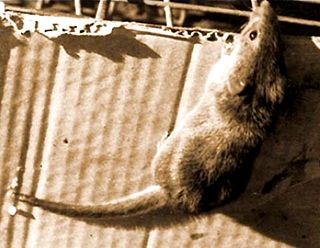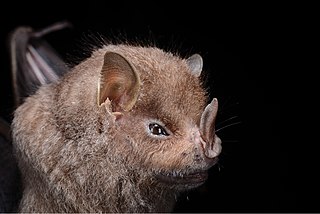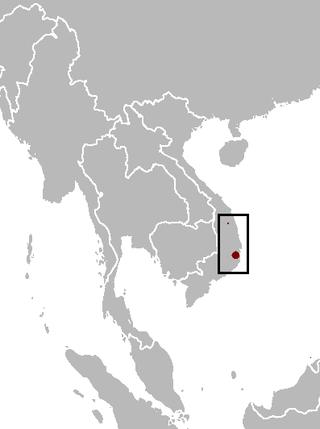
A hopping mouse is any of about ten different Australian native mice in the genus Notomys. They are rodents, not marsupials, and their ancestors are thought to have arrived from Asia about 5 million years ago.

Gould's mouse, also known as the Shark Bay mouse and djoongari in the Pintupi and Luritja languages, is a species of rodent in the murid family. Once ranging throughout Australia from Western Australia to New South Wales, its range has since been reduced to five islands off the coast of Western Australia.

Juscelinomys is a genus of burrowing mice. The name is derived from Brazilian president Juscelino Kubitschek who created the city of Brasilia where the Brasilia burrowing mouse was discovered.

Grulla, also called black dun, gray dun or mouse dun, is a color of horses in the dun family, characterized by tan-gray or mouse-colored hairs on the body, often with shoulder and dorsal stripes and black barring on the lower legs. The genotype for grulla horses is a black base with dun dilution. In this coloration, each individual hair is mouse-colored, unlike a roan, which is composed of a mixture of dark and light hairs. The several shades of grulla are informally referred to with a variety of terms, including black dun, blue dun, slate grulla, silver grulla or light grulla, silver dun, or lobo dun. Silver grulla may also refer to a grulla horse with silver dapple, regardless of shade. In the Icelandic horse, the grulla color is called gray dun, in the Highland pony it is called mouse dun, and in the Norwegian Fjord horse, grå or gråblakk.

The heath mouse is a species of mouse in the subfamily Murinae, the Old World rats and mice, found in Australia.
The northern grass mouse, or northern akodont, is a species of rodent in the family Cricetidae. It is found in Brazil, Colombia, Venezuela and Trinidad and Tobago.
Lemniscomys linulus, commonly known as the Senegal grass mouse or Senegal one-striped grass mouse, is a species of rodent in the family Muridae. It is found in Ivory Coast, Guinea, Mali, and Senegal and its natural habitat is dry savanna. At one time considered to be a subspecies of Lemniscomys griselda, it is now accepted as a species in its own right.
The Macedonian mouse is a species of rodent in the family Muridae and order Rodentia. This rodent lives in the area from eastern Georgia and western Bulgaria to Israel. It is considered part of a Palearctic group along with three other species: the house mouse, steppe mouse, and Algerian mouse.
The false canyon mouse or Coronados deer mouse, is a species of rodent in the family Cricetidae. It is known only from Coronados Island, a small island in the Gulf of California, part of Baja California Sur, Mexico. The species is threatened by predation by feral cats, and the IUCN has assessed its conservation status as "critically endangered".
The slender harvest mouse is a species of rodent in the family Cricetidae. It is small and mouse-like and is distributed throughout a portion of Central America.

The eastern harvest mouse is a species of rodent in the family Cricetidae. It is endemic to the Southeastern United States. Its natural habitats are subtropical or tropical seasonally wet or flooded lowland grassland, swamps, and pastureland.
Scolomys melanops, also known as the short-nosed scolomys, South American spiny mouse, Ecuadorian spiny mouse, or gray spiny mouse, is a species of rodent in the genus Scolomys of family Cricetidae. It is a forest mouse and was thought to be endemic to Ecuador but it is now known to have a wider distribution, being also present in part of Peru.

The pale kangaroo mouse or Soda Spring Valley kangaroo mouse is a species of rodent in the family Heteromyidae. It is endemic to California and Nevada in the United States.

The Guadeloupe big-eyed bat is a species of bat in the family Phyllostomidae. It is found in Guadeloupe and Montserrat. It is threatened by habitat loss mostly because of Hurricane Hugo, which destroyed 90% of its population in 1989. The species may be locally extinct in some areas of Guadeloupe.

The eastern spiny mouse or Arabian spiny mouse is a species of rodent in the family Muridae. They have a wide range, having been found in Middle Eastern deserts, as well as being prevalent in riverine forests in Africa. This is the only species of spiny mouse which may have black coloration. Their diet is similar to other species of spiny mouse, consisting mostly of seeds.

The Vietnam mouse-deer, also known as the silver-backed chevrotain, is an even-toed ungulate in the family Tragulidae known only from Vietnam. It was first described in 1910 by British zoologist Oldfield Thomas, who procured four specimens from Nha Trang in Annam. Little is known about its distribution and ecology. After 1910, the Vietnam mouse-deer was reported next in 1990 near Dak Rong and Buon Luoi in the Gia Lai Province. With increasing hunting pressure, habitat loss due to deforestation and no more reports of the species in the wild, the mouse-deer was feared to have gone extinct. The IUCN listed the species as Data Deficient in 2008. In 2019, a study confirmed the presence of the Vietnam mouse-deer in dry low-lying forests of southern Vietnam with camera trap evidence. The mouse-deer is characterised by a rough coat with a strange double-tone coloration unseen in other chevrotains; the front part of the body is reddish brown and contrasts strongly with the greyish posterior. It has big reddish brown ears, white and dark reddish brown marks on the throat.
The Rio Guaporé mouse or Guaporé akodont was formerly considered a rodent species in the family Cricetidae. It is known only from a small savanna in eastern Bolivia near the Rio Guaporé. However, in 2012 it was described as being conspecific with J. huanchacae.
The Huanchaca mouse or Huanchaca akodont is a rodent species in the family Cricetidae. It is known from savannas in an area at an elevation of 700 metres (2,300 ft) in Serrania Huanchaca, Noel Kempff Mercado National Park in eastern Bolivia.

Petter's big-footed mouse, is a Madagascan rodent in the genus Macrotarsomys. With a head and body length of 150 mm (5.9 in) and body mass of 105 g (3.7 oz), it is the largest species of its genus. Its upper body is brown, darkest in the middle of the back, and the lower body is white to yellowish. The animal has long whiskers, short forelimbs, and long hindfeet. The tail ends in a prominent tuft of long, light hairs. The skull is robust and the molars are low-crowned and cuspidate.












